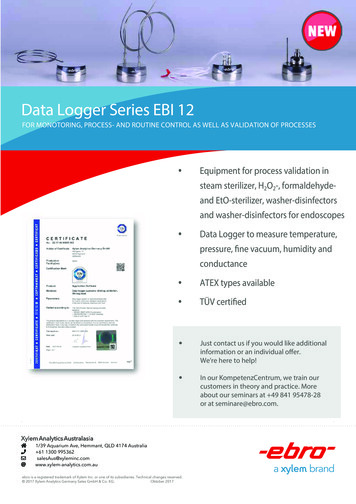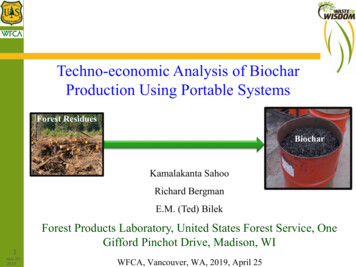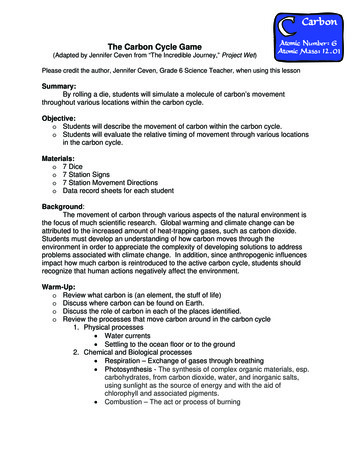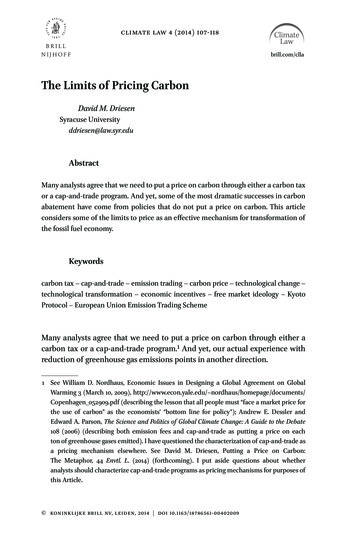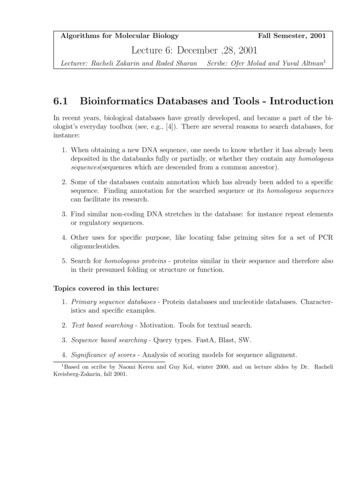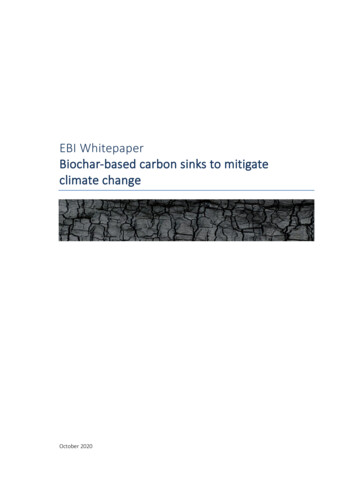
Transcription
EBI WhitepaperBiochar-based carbon sinks to mitigateclimate changeOctober 2020
PublisherEuropean Biochar Industry Consortium e.V. (EBI)Paul-Ehrlich-Straße 779106 FreiburgAuthorsHarald Bier (EBI)Helmut Gerber (EBI, PYREG GmbH)Marcel Huber (EBI, SynCraft Engineering GmbH)Dr. Hannes Junginger (carbonfuture GmbH)Prof. Dr. Daniel Kray (Hochschule Offenburg)Dr. Jörg Lange (CO2-Abgabe e.V.)Hansjörg Lerchenmüller1 (EBI, Carbuna AG)Pål Jahre Nilsen (EBI, VOW/ETIA)1Corresponding author (hansjoerg@lerchenmueller-consulting.com)i
Executive summaryExecutive summaryThe threat of climate change is increasing constantly. This is seriously bad news. And as this becomes moreand more understood and accepted, the pressure on policymakers and business to act is also growing. Asa result not only the European Union but also many companies have set themselves the goal of becomingclimate neutral. The concept of climate neutrality means creating carbon sinks (negative emissions) whosevolume is equal to that of carbon emissions.However, the potential for carbon sinks is limited and it will take years or even decades to develop them.Moreover, since the CO2 content in the atmosphere is already too high, it is imperative that swift and uncompromising action is taken to reduce emissions. From a technological point of view, industrialised economies have all the solutions necessary to be able to reduce their emissions by 90 - 95% in the next 15 - 20years.Emissions reduction alone, however, is no longer sufficient to contain the climate crisis. In parallel with thereduction of emissions, a start must now be made on expanding and further developing the existing optionsfor creating carbon sinks. The magnitude of the task is enormous: in order to achieve climate neutrality inthe European Union, the volume of sinks to be created annually must increase to at least 850 million tonnesof CO2 by the year 2050.Three solutions: afforestation/reforestation; biochar/biomass pyrolysis; and the build-up of soil organicmatter can be implemented in the short and medium term and there is no reason why they should not beexpanded rapidly. They can be implemented at a relevant volume in the short term, they are cost-efficientbecause in spite of their costs they have primary or additional benefits and, if implemented well, they donot have a negative but in most cases a clearly positive impact on ecosystems.Biochar/biomass pyrolysis is thus a key technology for saving the climate. Biochar has been intensively researched in recent years. A wealth of experience with its applications and innumerable scientific publications prove today that in addition to its direct climate benefit as a carbon sink, biochar can be used inagriculture in many profitable and beneficial ways. Biochar can help to increase yields, promote humusformation, increase the water storage capacity of soils and thus raise their resistance to drought, and reduce greenhouse gas emissions such as methane and nitrous oxide as well as nitrate leaching.For carbon sinks to be created on the scale that is necessary, a carbon sink economy with appropriatefinancial incentives is needed. It is crucial that robust systems are developed that are auditable, that reliablyavoid double counting and that map the durability of carbon sinks and thus the actual climate impact withscientifically sound calculation methods.The good news is that with determined and targeted action, it is possible to prevent a fundamental climatecrisis by reducing emissions and creating carbon sinks. So, let’s get going.iii
EBI WhitepaperTable of contentsExecutive summary . iiiTable of contents . ivKey terms . vList of abbreviations . vForeword . vi1The need for carbon sinks . 92Negative Emission Technologies . 133Biochar as Negative Emission Technology . 2043.1Persistence of biochar in various applications . 223.2Potential of the sink capacity of biochar/PyCCS. 233.3Application benefits of biochar . 25Emergence of a carbon sink economy . 294.1Accounting principles for carbon sinks: No sink is forever . 304.2Remuneration of carbon sinks . 325Recommendations for action . 366Bibliography . 38iv
Table of contentsKey termsBiochar: A porous, carbonaceous material produced by pyrolytic carbonization of biomass.Carbon sequestration: Process of capturing and storing atmospheric carbon dioxide.Carbon sink: Reservoir that temporarily or permanently absorbs and stores carbon.Pyrolysis: Thermochemical conversion of organic compounds, particularly biomass, in an oxygen-limitedenvironment at high temperatures.List of abbreviationsCH4MethaneCO2Carbon DioxideEBCEuropean Biochar CertificateGtGigatonsIPCCIntergovernmental Panel on Climate ChangeNDCsNationally Determined ContributionsNETsNegative Emission TechnologiesNO3NitrateN2ONitrous oxidePyCCSPyrogenic Carbon Capture and StorageSDGsSustainable Development GoalsSOMSoil Organic Matterv
EBI WhitepaperForewordScientific and public interest in biochar began to grow at the beginning of the 2010s and has developedconsiderably since then. The original focus of biochar research was on Terra Preta and soil improvementbut it is now clear that this singular focus on below ground uses of biochar was unnecessarily restrictive.There is a much wider range of applications for biochar, including in industrial and construction contexts.But it is also now understood that the use of biochar in agriculture is far more complex than was initiallyassumed since a great many factors influence crop response. Biochar is clearly not a panacea that will bringincreased yields to all agricultural crops, in any type of soil, using any application method or rate. However,we do know that there are agricultural applications in all climate zones in which biochar can offer greatecological and economic added value. This does not only mean increasing yields, but also counteractingthe loss of humus in the soil, preventing nitrate leaching and improving water storage capacity and thusresistance to drought. The use of biochar in urban trees has proven to be an effective means of counteracting increasing climate-related stress. The question is no longer whether biochar functions as a soil conditioner, but where and how it has the greatest effect and where its use makes the most economic sense.Beyond this, more and more applications of biochar are emerging outside agriculture.Above all, however, it is becoming increasingly clear that we cannot do without the production and use ofbiochar when it comes to climate protection. Due to the level of CO2 already accumulated in the atmosphere, it is no longer sufficient to simply emit less CO2. If we are to achieve the Paris climate targets andlimit the increase in global temperature to well below 2 C, we urgently need the massive and rapid buildup of carbon sinks or so-called negative emissions, which capture and store carbon from the atmosphere.Biochar is one of the few proven solution options with significant potential, which, if used properly, canalso provide a wide range of additional benefits in addition to carbon sequestration. The use of biochar hasan evidently positive effect on the outcome of many of the United Nation’s Sustainable Development Goals(SDGs). In this document we show that biochar can make a significant contribution not only to mitigatingclimate change but also to developing more sustainable agriculture. But anyone who believes that biocharcan solve the problem of climate change as a "silver bullet" in one shot will be disappointed: Biochar alonewill not save the planet and certainly not if it is not accompanied by a massive reduction in emissions.There is, however, another aspect: carbon and carbon compounds nowadays are not only energy sourcesbut also important raw and primary materials for industry. With the necessary phase-out of the fossil energy industry, many of these raw materials and supplies required by industry will no longer be available inthe future or will no longer be available at today's prices, especially if the associated CO 2 emissions areappropriately priced. This is a further area in which biogenic carbons can provide new perspectives.vi
ForewordIn the last 10 years there has been rapid development of both research and development activities as wellas practical applications for biochar. These practical applications and methods have developed considerably as a result of the experience gained and lessons learned. Anyone whose knowledge and expertise ofbiochar is based on scientific research from 5 years ago or longer and has not kept up to date with recentdevelopments is excluding up to 80% of the knowledge available today.This whitepaper, initiated by the European Biochar Industry Consortium EBI, focusses on the climate issueaspect of biochar, i.e. the need to create carbon sinks and the opportunities that the use of biochar offersfor climate protection. It will also address other crucial features of biochar, in particular significant environmental aspects other than direct carbon storage and discuss the various benefits of applications of biochar.This paper is based on extensive research on current scientific work on climate change, negative emissionsand biochar. Its aim is to encourage a wide range of interested readers to look at biochar from a variety ofperspectives and to rethink carbon cycles. In particular, the paper is aimed at: Decision-makers in politics or in local authorities looking for solutions to urgent issues in the context of climate change or the degradation of soils used for agriculture. Journalists and others working in the media and environmental organisations who have comeacross the subject of biochar and want to get an up-to-date picture. Investors considering investing in the fast-growing biochar market and people thinking about pursuing a professional career in the biochar sector. Farmers and gardeners who either already use biochar and have learned about its effects in practice, or are considering using it. Scientists researching individual aspects of biochar or climate change or negative emissions andwould like to learn about the broader context of the subject of biochar. Anyone who cares about climate and environmental protection.We would like to express our sincere thanks to all those whose input, criticism, viewpoints and contributions to discussion have helped us to hone the arguments and reach conclusions in this white paper.Hansjörg LerchenmüllerFreiburg, October 2020vii
Biochar for Mitigation of Climate Change1The need for carbon sinksClimate change is the central threat to life on earth as we know it today. It has long since become a tangiblereality for almost everyone and is no longer just an abstract theory of climate scientists. The importance ofclimate protection has thus entered the consciousness of the European population and has ultimately ledto it becoming an important political issue in many countries of the world, and especially in the policy ofthe European Union (EU). At the end of 2018, the EU declared the political goal of achieving climate neutrality by 2050, and in 2019 both the European Parliament and the European Council endorsed this goal.At the beginning of 2020, it was announced that it would also be enshrined in law and a proposal for corresponding legislation has already been submitted (EU, 2020). The EU's goal of making Europe the world'sfirst climate-neutral continent by 2050 is considered the core of the European Green Deal.At the same time, climate protection has also become an important issue for companies, corporations andnot least for the whole financial sector. In order not to jeopardize access to capital markets, good supplierqualifications and, ultimately, employee and customer goodwill, companies today must put forward a credible and ambitious sustainability strategy. Whether such a path is taken out of a sense of responsibilitytowards future generations or because of concerns about losing competitiveness is more or less irrelevant.What is critical is that climate-responsible action becomes established, the emission of greenhouse gasesis no longer taken for granted and that more and more politicians, corporate leaders and private individualsare genuinely concerned about doing what is within their sphere of influence to prevent a fundamentaland irreversible climate crisis. More and more companies today have not only a sustainability strategy, butalso a dedicated plan to achieve climate neutrality. In the last year and a half corporations seem to havebegun to compete with each other over the announcement of climate neutrality goals. But how these goalsare to be achieved in concrete terms is less clear. Tree planting projects are frequently staged in a way tobest garner public attention, simply because everyone at least understands that a tree binds carbon. Theremoval of carbon from the atmosphere and its storage over a longer period of time is what geoscientistscall a carbon sink. However, the complexity involved in this process in order for it to be effective is oftenunderestimated or is more or less purposely obscured by scientifically unjustifiable simplifications.Two fundamentally different lines of action are required to achieve climate neutrality: on the one hand,reducing carbon emissions, and on the other, creating carbon sinks. Let us first look at the emissions reduction side. The good news is that humanity already has all the solutions needed to quickly phase outfossil fuels such as lignite and hard coal, crude oil and gas. Numerous studies and model calculations showthat a 95% reduction in energy-based greenhouse gas emissions by 2050 compared to 1990 levels is technically and systemically feasible for industrialised economic areas. For Germany, for example, it has beenshown that energy-related emissions can be reduced by 90 - 95% even as early as 2035, albeit neces9
EBI Whitepapersitating higher costs and more radical behavioural changes leading to lower energy consumption (Fraunhofer ISE, 2020). In addition to energy-based emissions, however, process emissions from industry mustalso be considered, for example in the production of concrete or steel. Emissions from agriculture, especially methane emissions from livestock farming and nitrous oxide emissions from agricultural soils as aresult of nitrogen fertilization will also need to be curbed. These emissions can also be reduced by appropriate processes and practices, although certainly not to the same extent as is possible for energy-relatedemissions. Land management can also generate CO2 emissions from the decomposition of soil organic matter. In particular, further conversion of grassland into arable land and the drainage of bogs should thereforebe avoided as far as possible. The following exemplary scenario for emissions in the European Union illustrates the dimension of the remaining residual emissions. If all energy-related emissions are reduced to10% of 1990 levels by 2050 and the historic annual reductions in non-energy-related emissions are doubledthrough increased efforts, the result is that, in relation to the 1990 reference value, around 15% of emissions will still remain (the authors' own rough calculation, see Figure 1).Thus, in order to achieve climate neutrality in 2050 in this scenario by means of strong emission reduction,as proclaimed by the EU, the amount of carbon that would need to be sequestered would be in the orderof 15% of 1990 emissions, that is roughly 850 million tonnes of CO2 equivalents.Imported and exported emissions due to global supply chains must also be taken into account in order toachieve overall climate neutrality. The European Union currently imports about 700 million tonnes of CO2net from trading goods and services, which are emitted outside the EU (EU, 2/2020). It is crucial to consistently include this accounting aspect, especially if there are CO2 price imbalances between different economic areas, in order to ensure a level playing field.10
Biochar for Mitigation of Climate ChangeFigure 1: Historical emissions of the European Union (EU28) with reduction scenario. Scenario assumptions: Energyrelated emissions are reduced by 6% per year from 2018, so that by 2050 they fall to 10% of 1990 levels. For nonenergy-related emissions, the reduction effort is doubled. The result is 15% of 1990 emissions. Climate neutrality therefore means creating carbon sinks on this scale at the very least.The challenge of an annual target of 6% reduction comes into perspective when compared to the barely1% reduction achieved in the EU between 1990 and 2017. Precisely because emission reduction targetsmust be ambitious, politicians often try to find a way out of a consistent emission reduction policy by focusing on carbon sinks. But this is not working either, because at present there is no indication that sufficient sink potential can be tapped quickly enough (Nordhaus, 2019). This makes it clear: unless emissionsare reduced across the board and without compromise, climate neutrality is an unrealistic goal.If climate neutrality is reached at a single point in time, such as the year 2050, this will be a major milestone.However, this would only be a first step and there will still be a long way to go. This is because the CO2content of the atmosphere is already over 410 ppm (parts per million) today and will continue to rise untila balance has been achieved between annual emissions and carbon sinks. Thereafter, it will still be necessary to remove carbon from the atmosphere and store it safely far in excess of the level of residual emissions in order to lower the levels of CO2 in the atmosphere.The interaction of emission reduction and the creation of carbon sinks, as well as the need not just for onebut for both, is clearly illustrated by the graph over time. The animated graphics of the Norwegian climatescientist Glen Peters show this in a particularly vivid way (Peters, 2018).11
EBI WhitepaperFigure 2: Historical and future CO2 emissions in an IPCC scenario (RCP1.9) in which the Paris climate target can beachieved by a combination of rigorous emission reduction and massive build-up of carbon sinks. The brown curveshows the path of emission reduction, the green curve the path of sink build-up. The light grey lines correspond toalternative paths where even faster emission reduction would lead to a reduction in the build-up of carbon sinks necessary to achieve the climate target. In this scenario the sink capacity must already increase in the year 2050 to about10 Gt CO2.Without carbon sinks, also known as negative emissions, climate neutrality and thus the Paris climate goalscannot be achieved. Carbon sinks have long been part of most IPCC scenarios and are already included inprinciple in the EU's climate protection plans. Even if all possible emission reductions were consistentlyimplemented, without negative emissions the temperature rise would exceed the climate targets definedby the global community. This in turn would destroy the basis for a peaceful world, for prosperity and fora future worth living for future generations. Carbon sinks are necessary to secure the Paris climate protection goals but must not be a substitute for ambitious emission reductions. For this reason, it is essentialthat emissions and CO2 sinks are treated separately and are budgeted and balanced accordingly. This alsoapplies explicitly to corresponding emissions markets, such as the European emissions trading scheme andthe national reduction targets, the so-called Nationally Determined Contributions (NDCs).There is no alternative approach other than creating carbon sinks while simultaneously reducing emissions.From a climate science perspective, the goal is clear: we urgently need a roadmap with clear targets tocreate carbon sinks at a volume of at least 15% of 1990 emissions throughout the EU by 2050 at the latest.Verifiable, safe and long-lasting carbon sinks must be implemented alongside emission reductions. Only inthis way can climate neutrality become a reality, only in this way can a major climate crisis be prevented.12
Biochar for Mitigation of Climate Change2Negative Emission TechnologiesThere is a range of viable methods of creating carbon sinks, also known as Negative Emission Technologies(NETs), that actively remove CO2 from the atmosphere. While removal of carbon from the atmosphere isimportant, what is crucial for carbon efficiency is sequestration (i.e. storage) over as long a period of timeas possible. The principles of carbon sink accounting are comparable to energy accounting in physics orfinancial accounting. In practice, however, accounting for carbon sinks while taking the system boundariesinto account is often challenging, and can be time-consuming and complex. In response to this it is crucialthat calculations are transparent, clearly documented and appropriately controlled. And yet current carbonsink accounting practices often lack clearly defined standards, especially with regard to the permanence ofthe sink. Overly simplistic calculation approaches are sometimes chosen and as a result the calculated sinkperformance may not stand up to scrutiny under scientifically sound assessment standards. Carbon sinksthat do not deliver what they promise are dangerous. If politicians and the population feel safe because ofmake-believe carbon sinks, initiatives that are urgently needed to tackle climate problems will be hindered.The concept of negative emissions attracted increased attention after the publication of the IPCC's FifthAssessment Report (IPCC, 2014) which led to a significant intensification of work on this topic. Some of theearly reviews on negative emissions still include technologies that on closer examination have been foundto be impractical, risky or to have low potential. Ocean fertilization, for example, is still frequently found inthe relevant overviews, even though there is now a broad consensus in the literature that this is not a viableoption to pursue (Fuss et al, 2018). In the meantime, numerous publications and studies are available thatprovide appropriate and clear definitions of the relevant system boundaries, interfaces and interactions.This means that there is now a solid basis for a well-founded overview of existing NETs and the opportunities and risks associated with the individual solutions and also showing the limits of what can be achievedby negative emissions (IPCC 1.5 #2, 2018; IPCC 1.5 #4, 2018; EACAC, 2018; Fuss et al., 2018; Smith et al,2019).According to the current state of technology and science, there are six negative-emission technologies (Figure 3) that not only have sufficient potential for sequestration under current or foreseeable economic conditions, but also have a risk profile that is at the very least manageable in terms of its ecological impact.13
EBI WhitepaperFigure 3: Overview of the six negative emission technologies that can be considered today as the most promising options for the creation of carbon sinks. Modified graph from (SRU, 2020) from which ocean fertilization and fossil CCStechnology has been removed.The development of a master plan for the creation of carbon sinks on a scale necessary for the mitigationof climate change is an urgent albeit herculean task. Policymakers must tackle it quickly and as a matter ofpriority, because even if it is technically feasible, the socio-economic and political aspects to be taken intoaccount are ultimately crucial to success.While it is tempting to develop strategies for each of the individual NETs they should not be considered inisolation. In some cases there may be competition between the different NETs when it comes to the use ofresources, such as such as land or biomass. At the same time there is enormous potential for synergies, forexample between afforestation and the build-up of Soil Organic Matter (SOM), or for the joint use of biochar and volcanic, siliceous rock flour to capture carbon by means of enhanced rock weathering (Amann &Hartmann, 2019). While the consideration of synergies may significantly increase the complexity of thesituation, it also opens up new opportunities and paths of action.14
Biochar for Mitigation of Climate ChangeFigure 4: Synergies of biochar with other NETs.The following are some fundamental considerations that should guide procedures and prioritization in thedevelopment of carbon sinks: Diversification: From a risk minimization point of view, it makes sense not to focus on just one ora very small number of Negative Emission Technologies. Due to the undeniable need to createcarbon sinks, it is necessary from today's perspective to promote and further develop at least allthe options shown in Figure in a targeted manner. In addition, the implementation and volumescaling of the individual solutions involve different time horizons in each case. The developmentof cost-effective solutions for direct air capture, for example, will probably take decades, whileafforestation projects or the creation of biochar-based carbon sinks can be implemented quickly.Over time, climate conditions and economic priorities will also change and therefore it is not possible to determine without doubt which solutions are best. We also need to be able to changecourse when new knowledge is gained without having to start from scratch. Sink potential/scalability: It is vital that a solution is actually scalable and can reach a relevant andrealistic sink volume. Each of the solution options shown in the Figure have their own individualsink potential, which in the current literature is usually estimated at 1 - 5 Gt CO2 per year by 2050(IPCC 1.5 #4, 2018). Even individually, but especially in combination, these solutions show a relevant potential.15
EBI Whitepaper Modularity: The modularity of the solution, i.e. the question of whether an implementation canonly be realized on a large scale or also on a small scale, must be taken into account. A look at thesuccess story of photovoltaics, for example, shows that it can be of great advantage for rapidscalability if the modularity of the solution allows for both large-scale and small-scale implementation. Rapid feasibility and maturity of the solution: The development of relevant sink volumes requirestime. If we want to achieve climate neutrality in Europe by the middle of the century, we muststart today to push ahead at least with market-ready solutions which can be considered low-riskor which have predominantly positive side effects ("no-regret" solutions). The question of howquickly a solution can be scaled up and how mature it is, especially with regard to the assessmentof risks, must be an important criterion for determining the setting of priorities and roll out timing. Exploiting local potential: While climate protection and CO2 are global issues, the day-to-day, yearby-year work of rebalancing carbon is to be achieved at local, regional and national levels. A complete or predominant outsourcing of the task of creating sinks to other countries and regions cannot be expedient. This is the case not only because of locally limited land and resources, but alsobecause the political and socio-economic impact of import solutions, especially on developing andemerging countries, may not be reliably predicted and local political changes can lead to the rapiddestruction of previously created carbon sinks. This is a particularly high risk for afforestation projects, which are not inherently stable carbon sinks. This means the basic principle has to be tosensibly exploit the potential available in one's own country. In addition, it is important that theindustrialized nations should develop technical and socio-economic safety barriers. Carbon-efficient use of biomass and cascading uses: Whenever resources are limited, efficiencyshould play a decisive role. Biomass can either be fully combusted for energy generation or usedto create a carbon sink. Carbon efficiency must therefore always be taken into account when creating sinks. "You can't have your cake and eat it", as the saying goes, and in the case of biomass,this means that it can either be burned or used to create a sink but not both. One could take theproverb a step further and say "you can't eat your cake tw
European Biochar Industry Consortium e.V. (EBI) Paul-Ehrlich-Straße 7 79106 Freiburg Authors Harald Bier (EBI) Helmut Gerber (EBI, PYREG GmbH) Marcel Huber (EBI, SynCraft Engineering GmbH) Dr. Hannes Junginger (carbonfuture GmbH) Prof. Dr. Daniel Kray (Hochschule Offenburg) Dr. Jörg Lange (CO2-Abgabe e.V.)

